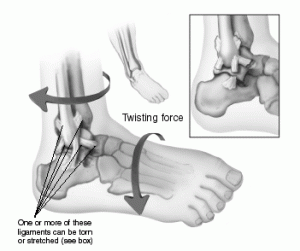Top 5 Common Tennis Injuries & Prevention
Call us +65-8368-7277 or fill in the Form~we will help you arrange a Tennis coach
According to a recent research study, there are about 54 injuries that result per 1000 tennis matches, making tennis one of the most famous sports that put players to less injury risk compared to soccer, golf and track-and-field. However, it never feels good to see yourself or your opponent get injured during a tennis match. So, here are the five most common tennis injuries and how to prevent each one of them.
1. Sprained Ankle
 Definition:
Definition:
Perhaps the most frequently experienced injury by tennis players, sprained ankle is caused by quick and sudden movements of the legs and the feet, especially on a sideway direction. This leads to the painful twisting of the ankle, damaging both tissues and ligaments of the ankle. Swelling and pain are the symptoms of sprained ankle, and bleeding may also be experienced.
Prevention:
To lower your risk of sprained ankles, you may opt to apply an ankle brace, just like tennis stars Roger Federer and Andrew Murray. Make sure that you don’t play on a slippery surface. Also, take brief periods of rest to prevent fatigue.
2. Calf Strain
Definition:
The calf if a muscle group at the back of your lower leg. This group works very hard when you are attempting to execute a quick reaction against the shot of your opponent. When the calf is stretched with a force that goes beyond what it can handle, the tissues may tear, causing calf strain.
Prevention:
Effective muscle contractions are related to having a sufficient energy supply. This means that you can prevent calf strain if you consume a high carbohydrate diet, especially 48 hours before your tennis match. Foods rich in carbohydrates are rice, bread, cereals and healthy snack bars. In addition, don’t forget to drink 8 to 12 glasses of water a day. Take regular sips of water and/or sports drinks between matches.
3. Shoulder Bursitis
Definition:
Simply called by players as shoulder pain, shoulder bursitis is actually the inflammation of the “bursa” or the sac of fluid on your shoulder. When cuff muscles are overused, the bursa becomes inflamed between these muscles and the bones of the shoulder.
Prevention:
The goal of prevention is to avoid the impingement of the bursa between the bony prominence and the muscles of the shoulders. To do this, you must always perform a series of shoulder stabilization exercises, preferably under the guidance of a physiotherapist. Also, make sure that your progress in training must be slow so as not to put the shoulder into unnecessary fatigue.
4. Back Stress Fracture
Definition:
This type of fracture is caused by over fatigue of the lower back. The lower back pain worsens when playing, and resolves when at rest. When the player bends his back, it shows soreness. The same can be observed in the player stands on one leg. Lower back stress fracture can be diagnosed by a doctor through a scan.
Prevention:
Service is the major technique in tennis that often causes lower back stress fracture due to hyperextension of the spinal column and the rotation plus bending of the trunk to the side. Therefore, carefully practicing service and doing core stability exercises regularly are important.
5. Tennis Elbow
Definition:
Tennis elbow is a condition wherein the tendons and muscles of the forearm are inflamed. Pain is experienced when the outermost part of the elbow is touched; the hand is moved forward then back at wrist, or when the elbow is on a straight position.
Prevention:
Your grip must be appropriate to prevent tennis elbow. The handle of the racquet must be in accordance to the size of your palm. Take regular breaks and don’t grip too hard.


